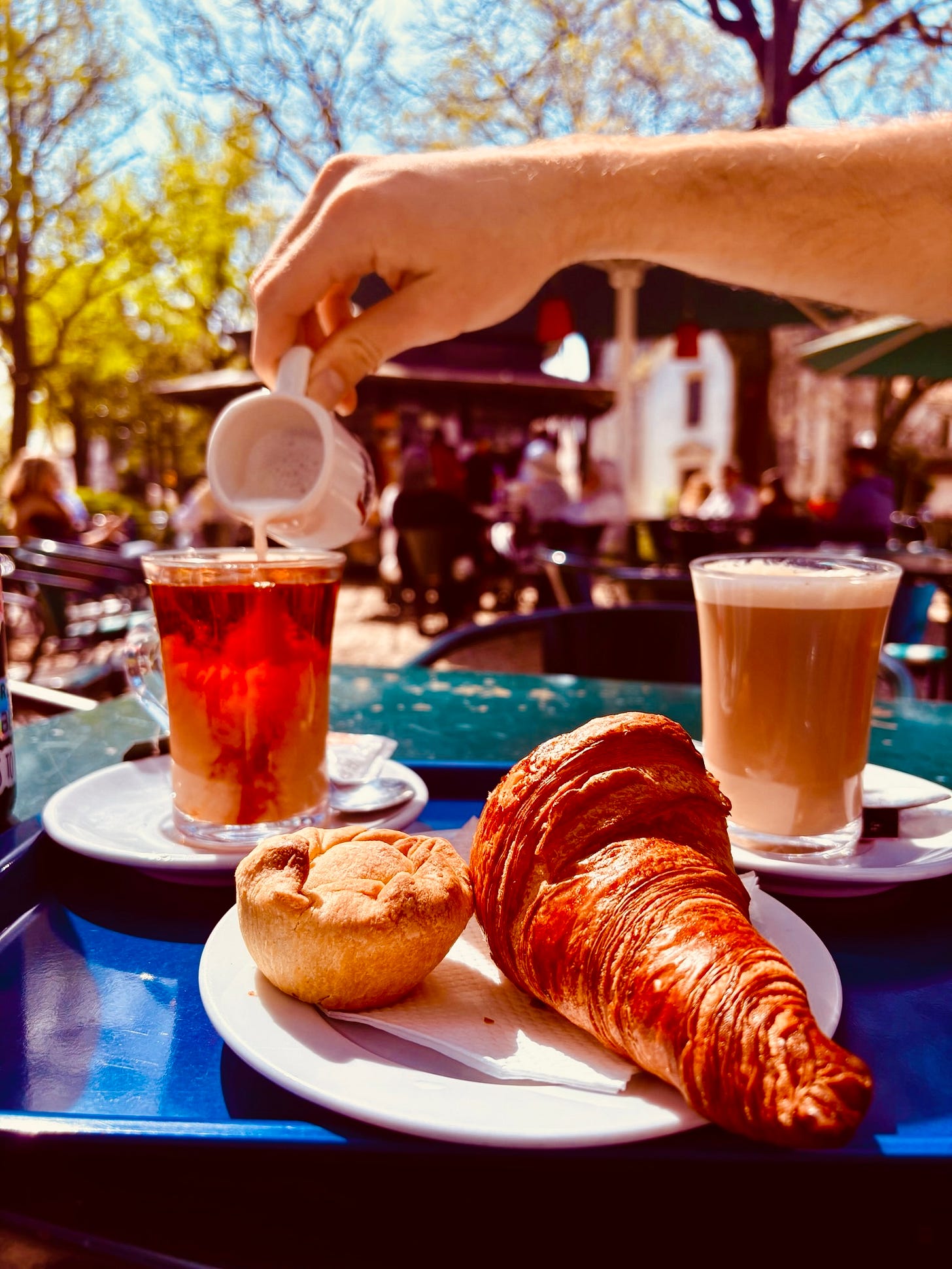
I didn’t move to Portugal to lose weight. I certainly wasn’t against the idea, but it wasn’t exactly a goal of mine either. Yet, despite an obsession with pastel de nata, bifanas, and vinho verde, and maintaining the same exercise routine I had for years in the U.S., I’ve lost 10 pounds since moving here in February. At 34, I can see my abs more clearly than I ever have. It’s still no six pack — that would likely require adding core work to my daily routine (which I’d really rather avoid). But it’s still a welcome confirmation that something about this new pace of life seems to agree with me.
Outside of a brief spell in fourth grade, I have always been, more or less, comfortable in my body. Back then in Indiana, my grandma would drive me to the mall to buy husky jeans, repeating the word “husky” so many times it became clear my weight gain had become an inconvenience. The next year, I started playing basketball, slimmed down, and ditched the jeans.
Since then, I’ve been content, never caring enough about bulking up to get serious about weightlifting and protein shakes. I’ve always silently judged men who are, which is convenient given I lack their discipline. I’ve always done just enough, I guess. I don’t count calories, but I run a couple times a week and play pickup occasionally when friends need another player. And thanks to prodding from my wife, Ashley, I’ve incorporated more healthy foods into my diet, like green juice and smoothies.
I could be more committed to clean eating, sure. But I’ve valued life’s simple pleasures — a late-night slice of pizza, a cold beer on a Friday afternoon, a couple scoops of ice cream on a summer evening — too much to make drastic changes.
Predictably, my half-hearted efforts caught up to me as my metabolism slowed. Before our move, my primary care doctor flagged an elevated cholesterol level at my annual check-up, and for the first time since donning husky jeans in fourth grade, I was starting to notice the early signs of a developing gut. None of this alarmed me too much. I was approaching my mid-30s, and gaining a little weight was probably just part of getting older. Besides, I had read somewhere that dad bods were in.
I understand being able to shrug off weight gain is a luxury not everyone has. Society may reward fit men, but we have options. Men can offset a lack of abs with a sense of humor, a respectable job, or a nice car. Women have fewer routes to social acceptance, and their value is too often, unfairly and relentlessly, tied to appearance. It’s evident in the extra 15 minutes Ashley needs to get ready before we leave the apartment, or in the morning regimen she goes through to look presentable for Zoom meetings I can just roll out of bed and log on to. It’s a rigged game I’ve been fortunate enough to play on easy mode.
That said, I didn’t move to Lisbon with a target weight in mind. I knew there were health benefits to living in a more walkable neighborhood, something we experienced on two trips through Europe. But what I really desired was connectivity, community, and a more vibrant lifestyle. The health benefits, if I’m honest, were an afterthought; a nice-to-have.
I certainly wasn’t thinking about improving my eating habits when, fresh off the plane from NC, I approached the pasteleria around the corner from our apartment and ordered my first two pastéis de nata. One would have sufficed, but I had been dreaming of those flaky, warm, creamy Portuguese delicacies since flying back from our scouting trip the previous summer. There’s no harm in indulging some, especially when celebrating a move abroad.
The only problem is I haven’t stopped. I have enough self-restraint not to order two natas every time, but settling for one has been the extent of my boundaries. When I get my daily coffee at the quiosque, I can rarely resist ordering one as they sit there beckoning from the case next to the register, priced at just over a euro.
If only pastel de nata were my only weakness. I’ve also developed a fondness for queque — golden, buttery muffins that practically melt in your mouth with each bite — and empada de galinha — well-seasoned shredded chicken tucked inside a flaky pastry shell. Both are easy enough to find at quiosques and cafes all over the city that I never have to seek them out. They always find me.

Pastries are only one piece of the puzzle. Before attending my first Benfica match, I arrived early to soak in the atmosphere. Across the street from the stadium, a row of food carts stretched along the sidewalk, packed with fans sipping beverages and trading banter. It didn’t take long to realize they were all selling the same thing: beer and bifanas. Why fix what’s not broken? I had tried a bifana before and enjoyed it, but something about that tender, slow-marinated pork between a soft-yet-crunchy roll paired with a cold Super Bock, surrounded by the energy of match day, just hit differently. The tradition, the simplicity of it swept me away, and I’ve been hooked ever since.
And then there’s the wine. I was never much of a wine drinker back in the U.S.; wine culture just felt fussy and unapproachable. The swirling, the sniffing, the endless range of regions and styles. It was all a little much, not to mention expensive. But that was all before I tried a chilled glass of vinho verde to go with spicy grilled chicken from our neighborhood churrasqueira. Light, crisp, and slightly bubbly, the wine cut through the salt and heat like those grapes and that bird were destined to meet, like their separate origins from vineyard and farm were always meant to coalesce on my plate. It was unpretentious, affordable, and absurdly good, instantly converting me into a wine lover.
So, amid this indulgent culinary tour of our new home, how exactly have I been dropping pounds?
Well, if I’m honest, eating well here happens almost by accident — fresh produce is just as accessible as sweet treats and delicious wine; it’s literally spilling out onto the streets. For every flaky pastry you encounter, there’s a fresh bell pepper, cucumber, sweet potato, orange, and pear. For every bifana you find, there are rows of ripe tomatoes, bundles of spinach, overflowing baskets of grapes and strawberries. When you walk past two frutarias and a mini-mercado just outside your front door each morning, it makes balance feel more like a default than a discipline.
These neighborhood staples fill in the gaps between several supermarkets (Aldi, Auchan, Pingo Doce, and Continente) within a 10-minute walk, all seemingly competing to be our primary grocer. Just when we think we’re Aldi people, Auchan will turn our heads. I feel a little disloyal, but there’s a thrill in being wooed, even if the courtship is entirely imagined.
Back in the States, we reluctantly chose Harris Teeter over Whole Foods, the two grocery stores within a 15-minute drive, for slightly more affordable prices. In actuality, we loathed both. The fight for a parking spot. The unhappy people. The overpriced products. The blandness, the soullessness of it all. Just the thought of making a grocery run after a long day at work often led us to throw up our hands and order delivery instead.
Here, if we’re missing an ingredient, I just have to run downstairs to the mini-mercado in the time it used to take me to roll the trash and recycling bins to the curb. Eating healthily, for the first time in my life, is actually more convenient than not.
A recent study shed some light on the differences I’ve been experiencing. According to the National Library of Medicine, only 10.2 percent of food consumed per household in Portugal is ultra-processed, one of the lowest rates in all of Europe. By contrast, the same publication found that ultra-processed food consumption accounts for over half, a whopping 57 percent, in the United States, a rate that has been rising.
A high consumption of ultra-processed foods has been linked to weight gain, metabolic disorders, and a greater risk of chronic illnesses like heart disease and type 2 diabetes. It’s no wonder Portugal, despite being a significantly poorer country than the U.S., fares so much better in health outcomes, with much lower obesity rates and longer life expectancy averages for men and women.
Beyond eating less processed food, the daily habit of walking everywhere rather than spending the majority of a 24-hour span shuttling between bed, car, desk, and couch is also an obvious contributing factor. There is considerable research that shows people living in walkable neighborhoods have lower rates of obesity, improved cholesterol levels, reduced cardiovascular disease risk, lower diabetes rates, reduced hypertension risk, and lower cancer risk than those who live sedentarily in car-centric areas.
Maybe suburban houses should come with warning labels like cigarettes.
Beyond the research and statistics, I’ve felt these differences in my body, in my mood, in the way my days unfold. One of the gifts this move has given me is the ability to become healthier without turning health and wellness into an all-consuming identity. I haven’t had to consolidate the indulgences that make life joyful into a fleeting and guilt-filled “cheat” day. Here, improved health doesn’t seem to demand perfection or constant vigilance. Balance, for me at least, feels intuitive rather than imposed, weaving itself into the daily rhythm of life in the neighborhood.
That harmony, where fresh produce, tasty pastries, good wine, and daily movement can coexist, has grounded me during a period of major transition, offering a sense of ease and contentment when so much feels complicated and uncertain. And that, more than any change on the scale, is the kind of well-being I came looking for, even if I didn’t know it at the time.
Here are some additional ways you can support our work:




Yes! I ate pretty much what I wanted in Europe but with the walking and the cleaner ingredients (a lot of stuff used in the US is banned in the EU), the weight came off easily. I went down 2 pant sizes while in Edinburgh but with my daily routine. I didn't go to the gym there, I just walked and hiked, did some yoga, but that's it. As soon as I moved back to the US, the weight started to come back too.
I share your loathing of Harris Teeter. That is one of the most difficult aspects of going back to Durham to visit. Ugh.